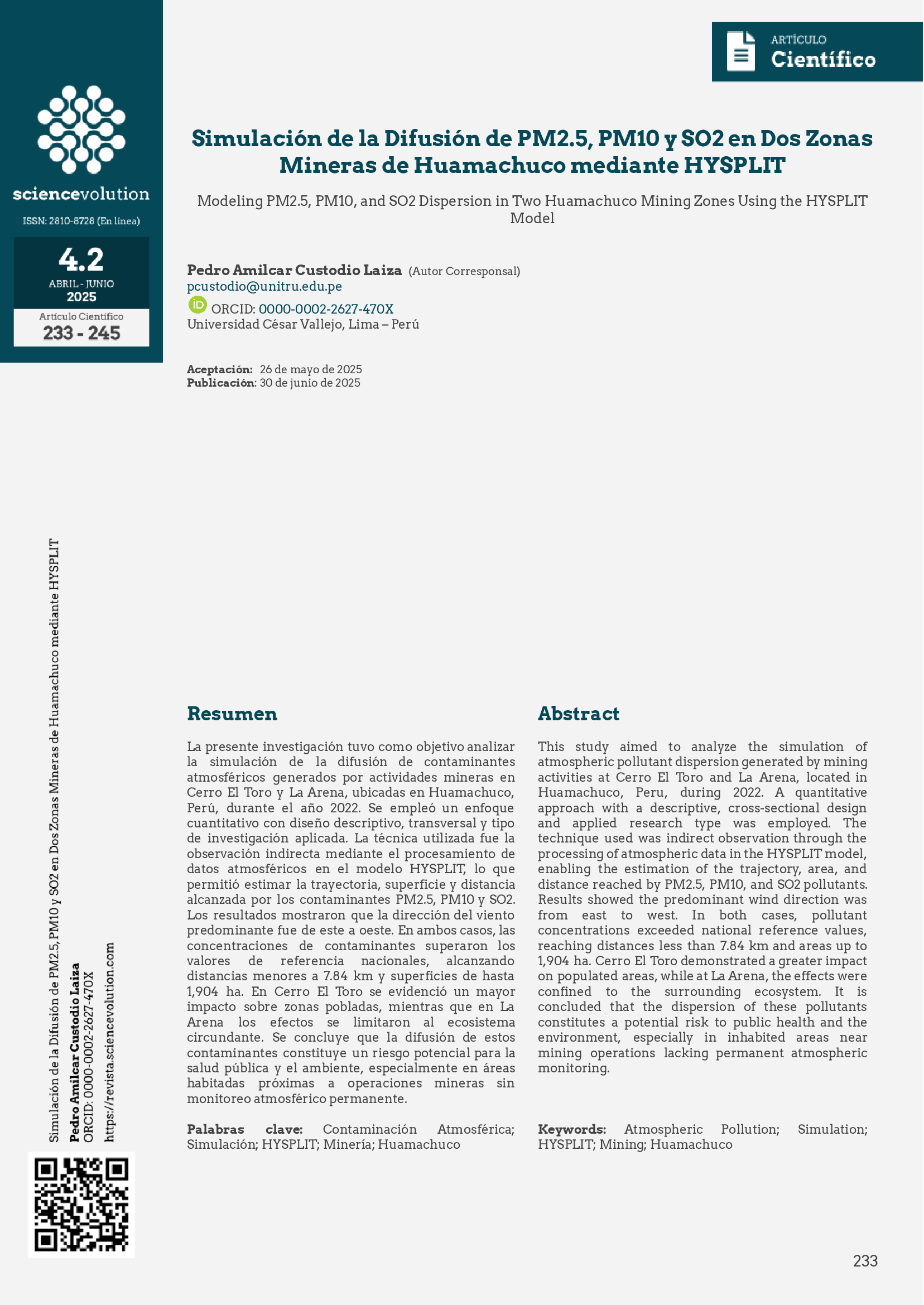Abstract
This study aimed to analyze the simulation of atmospheric pollutant dispersion generated by mining activities at Cerro El Toro and La Arena, located in Huamachuco, Peru, during 2022. A quantitative approach with a descriptive, cross-sectional design and applied research type was employed. The technique used was indirect observation through the processing of atmospheric data in the HYSPLIT model, enabling the estimation of the trajectory, area, and distance reached by PM2.5, PM10, and SO2 pollutants. Results showed the predominant wind direction was from east to west. In both cases, pollutant concentrations exceeded national reference values, reaching distances less than 7.84 km and areas up to 1,904 ha. Cerro El Toro demonstrated a greater impact on populated areas, while at La Arena, the effects were confined to the surrounding ecosystem. It is concluded that the dispersion of these pollutants constitutes a potential risk to public health and the environment, especially in inhabited areas near mining operations lacking permanent atmospheric monitoring.
References
Alva Huamán, D. A. (2019). Concentración de material particulado, monóxido de carbono, dióxido de azufre y dióxido de nitrógeno en la planta de producción de óxido de calcio Puylucana, Cajamarca 2018 [Tesis de maestría, Universidad Nacional de Cajamarca]. Repositorio Institucional UNC. http://hdl.handle.net/20.500.14074/3523
Ambastha, S. K., & Haritash, A. K. (2022). Emission of respirable dust from stone quarrying, potential health effects, and its management. Environmental Science and Pollution Research, 29, 6670–6677. https://doi.org/10.1007/s11356-021-16079-4
Bera, B., Bhattacharjee, S., Sengupta, N., & Saha, S. (2022). Variation and dispersal of PM10 and PM2.5 during COVID-19 lockdown over Kolkata metropolitan city, India investigated through HYSPLIT model. Geoscience Frontiers, 13. https://doi.org/10.1016/j.gsf.2021.101291
Chandra Joshi, D., Negi, P., Devi, S., Lohani, H., Kumar, R., Gupta, M., & Chiau Ming, L. (2025). Fine particulate matter (PM2.5, PM10): A silent catalyst for chronic lung diseases in India; a comprehensive review. Environmental Challenges, 20, 101215. https://doi.org/10.1016/j.envc.2025.101215
Clarity. (2023). Monitoreo de la calidad del aire en la minería: importancia y mejores prácticas. https://www.clarity.io/blog/monitoring-air-quality-in-mining-importance-best-practices
Collyns, D. (2024). Perú: Comunidades envenenadas por minería en Cerro de Pasco. Mongabay. https://es.mongabay.com/2024/01/peru-comunidades-envenenadas-por-mineria-cerro-de-pasco/
Cruz Núñez, X., & Bulnes Aquino, E. (2019). Emission impact of wildfires: El Tepozteco 2016. Atmósfera, 32(2), 85–93. https://doi.org/10.20937/ATM.2019.32.02.01
Cvetkovic Vega, A., Maguiña, J. L., Soto, A., Lama-Valdivia, J., & Correa-López, L. E. (2021). Estudios transversales. Revista de la Facultad de Medicina Humana, 21(1), 179–185. https://revistas.urp.edu.pe/index.php/RFMH/article/view/3069/4422
Ferrero, F., Abrutzky, R., Ossorio, M. F., & Torres, F. (2019). Efectos de la contaminación y el clima en las consultas pediátricas por infección respiratoria aguda en la Ciudad de Buenos Aires. Archivos Argentinos de Pediatría, 117(6), 368–374. http://dx.doi.org/10.5546/aap.2019.368
Hernández-Carrillo, F., Campillo Labrandero, M., & Sánchez-Mendiola, M. (2018). Investigación traslacional en ciencias de la salud: implicaciones educativas y retos. Investigación en educación médica, 7(28), 85-97. https://doi.org/10.22201/facmed.20075057e.2018.28.18146
Hernández-Garcés, A., Jáuregui-Haza, U., González, J. A., Casares-Long, J. J., Saavedra-Vázquez, S., Guzmán-Martínez, F., & Torres-Valle, A. (2016). Aplicaciones del modelo lagrangiano de dispersión atmosférica CALPUFF. Ciencias de la Tierra y el Espacio, 17(1), 32–44. https://www.iga.cu/vol17-no1-art3/
HYSPLIT. (2025). READY. Sistema de Visualización y Aplicaciones Ambientales en Tiempo Real. https://www.ready.noaa.gov/index.php
Ministerio del Ambiente del Perú. (2017). Decreto Supremo N° 003-2017-MINAM: Aprueban los Estándares de Calidad Ambiental (ECA) para Aire y establecen disposiciones complementarias. Sistema Nacional de Información Ambiental (SINIA). https://sinia.minam.gob.pe/normas/aprueban-estandares-calidad-ambiental-eca-aire-establecen-disposiciones
Ministerio del Ambiente del Perú. (2020). Concentración del material particulado (PM2.5) en Lima Metropolitana, 2014-2019 (μg/m³). Sistema Nacional de Información Ambiental (SINIA). https://sinia.minam.gob.pe/inea/indicadores/concentracion-del-material-particulado-pm2-5-en-lima-metropolitana-2014-2019-ug-m3/
Moghimi Dehkordi, M., Pournuroz Nodeh, Z., Soleimani Dehkordi, K., Salmanvandi, H., Rasouli Khorjestan, R., & Ghaffarzadeh, M. (2024). Soil, air, and water pollution from mining and industrial activities: Sources of pollution, environmental impacts, and prevention and control methods. Results in Engineering, 23. https://doi.org/10.1016/j.rineng.2024.102729
Monaci, F., Ancora, S., Paoli, L., Loppi, S., & Franzaring, J. (2022). Calidad del aire en pueblos postmineros: seguimiento de elementos potencialmente tóxicos mediante hojas de árboles. Environmental Geochemistry and Health, 45, 843–859. https://doi.org/10.1007/s10653-022-01252-6
Municipalidad de Lima. (2020). Calidad del aire en Lima mejoró durante estado de emergencia, según monitoreo sobre partículas contaminantes. Gobierno del Perú. https://www.gob.pe/institucion/munilima/noticias/576974-calidad-del-aire-en-lima-mejoro-durante-estado-de-emergencia-segun-monitoreo-sobre-particulas-contaminantes
Office of Environmental Health Hazard Assessment (OEHHA), State of California. (s.f.). PM2.5. Recuperado el 16 de mayo de 2025 de https://oehha.ca.gov/calenviroscreen/indicator/pm25
Organización Mundial de la Salud. (2024). Contaminación del aire ambiente (exterior). https://www.who.int/es/news-room/fact-sheets/detail/ambient-(outdoor)-air-quality-and-health
Ortínez-Álvarez, A., Ruiz-Suárez, L. G., Ortega, E., García-Reynoso, A., Peralta, O., López-Gaona, A., Castro, T., & Martínez-Arroyo, A. (2021). Emission inventory point source visualization on Google Earth and integrated with HYSPLIT model. Atmósfera, 34(2), 143–156. https://doi.org/10.20937/ATM.52834
Ramos Díaz, R., Viña Romero, M. M., & Gutiérrez Nicolás, F. (2020). Investigación aplicada en tiempos de COVID-19. Revista de la OFIL, 30(2), 93. https://dx.doi.org/10.4321/s1699-714x2020000200003
Rolph, G., Stein, A., & Stunder, B. (2017). Real-time Environmental Applications and Display sYstem: READY. Environmental Modelling & Software, 95, 210–228. https://doi.org/10.1016/j.envsoft.2017.06.025
Shahid, I., Chishtie, F., Bulbul, G., Shahid, M. Z., Shafique, S., & Lodhi, A. (2019). State of air quality in twin cities of Pakistan: Islamabad and Rawalpindi. Atmósfera, 32(1), 71–84. https://doi.org/10.20937/atm.2019.32.01.06
Shen, Y., Hu, X., Ma, Y., & Chen, G. (2017). Warning Technology for Air Nuclear Pollution Diffusion of Nuclear Power Plant. Journal of Northeastern University Natural Science, 38(10), 1482–1486. https://doi.org/10.12068/j.issn.1005-3026.2017.10.023
Shikwambana, L., Ncipha, X., Sangeetha, S. K., Sivakumar, V., & Mhangara, P. (2021). Qualitative study on the observations of emissions, transport, and the influence of climatic factors from sugarcane burning: A South African perspective. International Journal of Environmental Research and Public Health, 18(14), 7672. https://doi.org/10.3390/ijerph18147672
Swartz, J. S., Van Zyl, P. G., Beukes, J. P., Labuschagne, C., Brunke, E. G., Portafaix, T., Galy-Lacaux, C., & Pienaar, J. J. (2020). Twenty-one years of passive sampling monitoring of SO2, NO2 and O3 at the Cape Point GAW station, South Africa. Atmospheric Environment, 22. https://doi.org/10.1016/j.atmosenv.2019.117128
Thangavel, P., Park, D., & Lee, Y. C. (2022). Recent insights into particulate matter (PM2.5)-mediated toxicity in humans: An overview. International Journal of Environmental Research and Public Health, 19(12). https://doi.org/10.3390/ijerph19127511
United States Environmental Protection Agency. (s.f.). Regulatory and guidance information by topic: Air. Recuperado el 16 de mayo de 2025 de https://www.epa.gov/regulatory-information-topic/regulatory-and-guidance-information-topic-air

This work is licensed under a Creative Commons Attribution-NonCommercial-NoDerivatives 4.0 International License.

